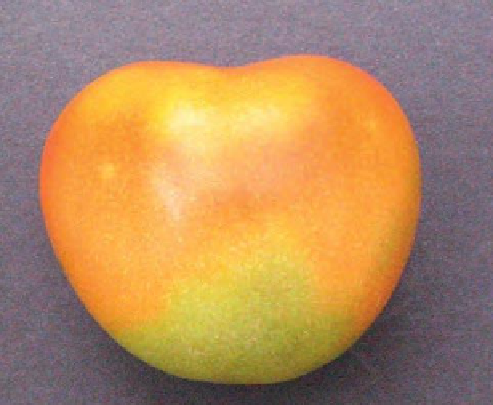Agriculture Reference
In-Depth Information
Petunia
. On cucumbers, a mottling of young leaves
occurs (see Figure 19.18) followed by a twisting
and curling of the whole foliage, and fruit may show
yellow sunken areas. On the shrub
Daphne odora
,
a yellowing and slight mottle is commonly seen on
infected foliage, while
Euonymus
leaves produces
bright yellow leaf spots. Infected tomato leaves are
reduced in size (fern-leaf symptom).
Life cycle.
The virus may be spread by infected hands,
but more commonly an aphid (e.g. peach-potato
aphid) is involved. Many crops such as lettuce, maize,
Pelargonium
and privet, and weeds such as fat hen
and teasel, may act as a reservoir for the virus.
Control
.
Since there are no curative methods for
control, care must be taken to use resistance and
cultural methods. Examples of resistant cultivars
available to the gardener are: 'Defender' courgette,
'Bonica' aubergine and 'Crispy Salad' cucumber.
Choice of uninfected stock is vital in vegetatively
propagated plants such as
Pelargonium
. Careful
control of aphid vectors may be important where
susceptible crops such as lettuce and cucumbers
are grown in succession, and when crops are next
to other susceptible species. Removal of infected
weeds, particularly from greenhouses, may help
prevent widespread infection.
Figure 19.19
Tomato mosaic symptoms on tomato
fruit
soil infection on roots of the previous crop. Hands
and tools should be washed in soapy water after
working with infected plants. Clothing may harbour
the virus.
Cultivars and rootstocks containing several factors for
resistance are commonly grown. 'Shirley', 'Sonatine',
'Cherry Wonder' and 'Estrella' are a few of many that
at present claimed have resistance. The virus' ability
to produce new strains always brings the possibility of
a variety's resistance breaking down.
Tomato mosaic (tobacco mosaic)
Damage
. This disease may cause serious losses in the
Solanaceae family of plants that includes tomatoes.
Infected seedlings have a stunted, spiky appearance.
On more mature plants leaves have a pale green
mottled appearance, or sometimes a bright yellow
('aucuba') symptom. The stem may show brown
streaks in summer when growing conditions are
poor, a condition often resulting in death of the plant.
Fruit yield and quality may be lowered, the green
fruit appearing yellow/bronze and the ripe fruit hard,
making the crop inedible (Figure 19.19).
Life cycle and spread
. The virus is able to enter plant
leaves through microscopic wounds such as broken
leaf hairs, or via the broken bases of de-leafed side
shoots. The period from plant infection to symptom
expression is about 15 days. The virus may survive
within the seed coat (testa) or endosperm of the
tomato seed. It is very easily spread on fingers of
gardeners as it is present in large numbers in the leaf
hairs of infected plants.
Control
. Heat treatment of dry seed at 70°C for
four days by seed merchants helps to remove initial
infection in susceptible cultivars. Peat growing bag
and nutrient-film methods enable the grower to avoid
Leaf roll virus of potato
Potatoes are one of the gardener's favourite crops.
The occurrence of this important virus disease in
a crop that is vegetatively propagated (see p. 133)
presents problems for control.
Damage
. The leaves of the plant show an upward
rolling (see Figure 19.20) caused by an accumulation
of starch in the pallisade mesophyll (see p. 215).
These leaves often are light green in colour; and may
turn red on the upper side, and purple on the lower
side. The leaves may also cause a rattling sound when
shaken against each other. Leaf roll virus does not
show any symptoms in the tubers, but can cause a
serious reduction in potato yield, especially when the
gardener re-uses tubers from the previous year's crop,
and when aphid numbers are high.
Life cycle and spread
. The main vector of leaf roll is
the peach-potato aphid (
Myzus persicae
, see also
p. 232). The aphid, while feeding on the sugars
present in phloem tissues of an infected potato,
will take up the virus, especially if it feeds for a few
hours. The virus may multiply in the aphid to such an
extent that the insect remains an active vector for

